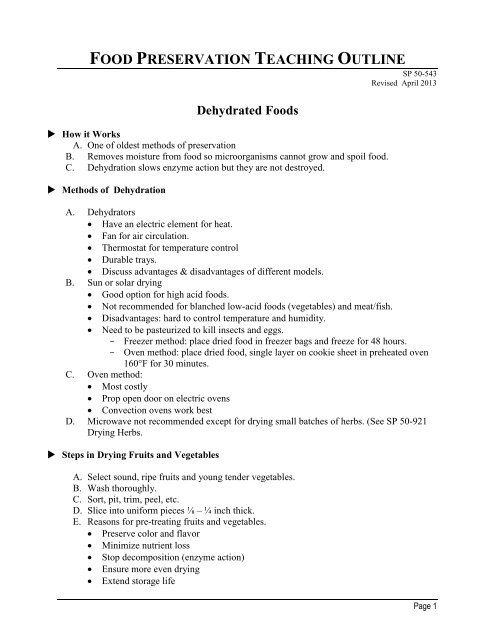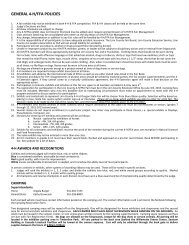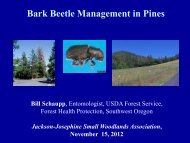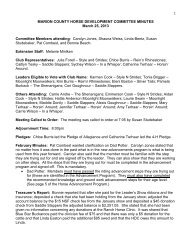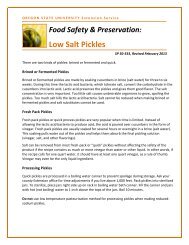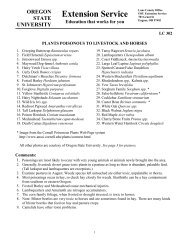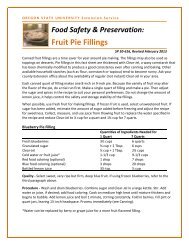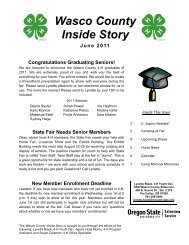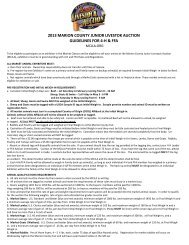food preservation teaching outline - Oregon State University ...
food preservation teaching outline - Oregon State University ...
food preservation teaching outline - Oregon State University ...
You also want an ePaper? Increase the reach of your titles
YUMPU automatically turns print PDFs into web optimized ePapers that Google loves.
FOOD PRESERVATION TEACHING OUTLINE<br />
SP 50-543<br />
Revised April 2013<br />
Dehydrated Foods<br />
How it Works<br />
A. One of oldest methods of <strong>preservation</strong><br />
B. Removes moisture from <strong>food</strong> so microorganisms cannot grow and spoil <strong>food</strong>.<br />
C. Dehydration slows enzyme action but they are not destroyed.<br />
Methods of Dehydration<br />
A. Dehydrators<br />
Have an electric element for heat.<br />
Fan for air circulation.<br />
Thermostat for temperature control<br />
Durable trays.<br />
Discuss advantages & disadvantages of different models.<br />
B. Sun or solar drying<br />
Good option for high acid <strong>food</strong>s.<br />
Not recommended for blanched low-acid <strong>food</strong>s (vegetables) and meat/fish.<br />
Disadvantages: hard to control temperature and humidity.<br />
Need to be pasteurized to kill insects and eggs.<br />
- Freezer method: place dried <strong>food</strong> in freezer bags and freeze for 48 hours.<br />
- Oven method: place dried <strong>food</strong>, single layer on cookie sheet in preheated oven<br />
160°F for 30 minutes.<br />
C. Oven method:<br />
Most costly<br />
Prop open door on electric ovens<br />
Convection ovens work best<br />
D. Microwave not recommended except for drying small batches of herbs. (See SP 50-921<br />
Drying Herbs.<br />
Steps in Drying Fruits and Vegetables<br />
A. Select sound, ripe fruits and young tender vegetables.<br />
B. Wash thoroughly.<br />
C. Sort, pit, trim, peel, etc.<br />
D. Slice into uniform pieces ⅛ – ¼ inch thick.<br />
E. Reasons for pre-treating fruits and vegetables.<br />
Preserve color and flavor<br />
Minimize nutrient loss<br />
Stop decomposition (enzyme action)<br />
Ensure more even drying<br />
Extend storage life<br />
Page 1
Enhance destruction of harmful bacteria.<br />
F. Methods of pre-treating fruit – See PNW 397 pg. 7 for amounts<br />
Choice of method is a matter of preference.<br />
Salt/vinegar soak (2-4 Tbsp. salt and vinegar/gallon of water). Soak for 3-5 minutes.<br />
Drain well<br />
Ascorbic acid / citric acid dip<br />
Syrup/water blanching<br />
Salt solution dip<br />
Honey dip<br />
Sulfiting<br />
Sulfite caution: label <strong>food</strong>s using sulfites because some individuals are very allergic.<br />
G. Pre-treating vegetables<br />
Why?<br />
- Inactivate the enzymes causing vegetables to mature.<br />
- Prevent vegetables from becoming bitter.<br />
- Prevent off flavors.<br />
- Cleans and softens them – easier to rehydrate.<br />
Methods of blanching.<br />
- Steam blanch<br />
- Water blanch<br />
- Follow time <strong>outline</strong>d (PNW 397 pgs. 20-22)<br />
- Drain well and pat dry<br />
- Some vegetables need no pre-treatment (onions, mushrooms, zucchini squash,<br />
green peppers, hot peppers and herbs).<br />
- Canned fruits and frozen vegetables can be dehydrated without pretreatment.<br />
H. Drying Methods<br />
Dehydrator<br />
Oven<br />
Sun<br />
I. Test for Doneness<br />
Fruits—leathery and pliable because of high sugar content<br />
Vegetables—most are hard and brittle. Green peppers, sweet onions, tomatoes and<br />
mushrooms dry more like fruit.<br />
J. Storage<br />
Conditioning (PNW 397 Pg. 13)<br />
Packing<br />
- Thoroughly cool <strong>food</strong>s.<br />
- Pack into clean, dry, insect proof containers (e.g. metal cans with tight fitting<br />
lids, glass jars, moisture-vapor proof freezer containers and bags.<br />
- Need to tape edge of lid to prevent insect infestation.<br />
- Store in cool, dark, dry location.<br />
K. Problems<br />
Case hardening caused by drying at too high a temperature. A crust forms on outside<br />
of <strong>food</strong> and moisture cannot escape.<br />
Browning: can be prevented by using a pretreatment, storing in dark location. Food<br />
safe to eat.<br />
Page 2
Mold—caused by <strong>food</strong> not dried enough or not stored properly so that moisture was<br />
re-absorbed by <strong>food</strong>.<br />
Sugar crystals—often happens with overripe fruit. Safe to eat. Will dissolve if<br />
cooked.<br />
Insect infestation.<br />
L. Rehydration and using dried <strong>food</strong>s<br />
Fruits<br />
- Can be eaten as is—no rehydration needed.<br />
- Can be rehydrated by:<br />
1. Pouring boiling water or juice on fruit. Let stand 5-10 minutes.<br />
2. Steam fruit over boiling water 3-5 minutes.<br />
3. Soak in cold water for several hours.<br />
4. Cover with water and bring to boil in microwave. Let stand 5-10 minutes.<br />
5. Soaking fruit first in cold water, then cooking gives a more tender product.<br />
- Chopping fruits<br />
1. Freeze fruit first then crush with hammer or meat cleaver.<br />
2. Put frozen fruit in blender or <strong>food</strong> processor.<br />
3. Cut pieces of fruit with scissors or sharp knife. If fruit tends to stick coat<br />
blade with a little cooking oil.<br />
Vegetables<br />
- Dried vegetables will be tenderer if soaked before cooking. Can take 15 minutes<br />
to 2 hours to plump. Then cook or add to soup or stew.<br />
- Take longer to rehydrate than fruit because more water is lost.<br />
- Do not let soaking vegetables stand longer than 2 hours without refrigeration.<br />
- Vegetable flakes and powders.<br />
- Can use blender or <strong>food</strong> processor to flake or make vegetable powders – great<br />
seasonings.<br />
Food spoilage<br />
- Rehydrated dried <strong>food</strong>s should be refrigerated. Very susceptible to spoilage.<br />
Fruit and Vegetable Leather<br />
A. What is it?<br />
B. Leathers are a chewy product usually made from pureed fruits but some vegetables like<br />
tomatoes also make good leather.<br />
C. What fruits to use<br />
Fresh fruits<br />
- Any fresh fruit will work—good place to use culls, overripe fruit or those not<br />
suitable for canning or freezing.<br />
- Cut away all bruises and spoiled portions.<br />
- Citrus fruits should be used in combination with other fruits because they are so<br />
juicy.<br />
- Fresh fruit purees are usually too thin to use as is-need to be cooked to thicken<br />
or blend with drained canned fruit such as pears or apple sauce.<br />
Page 3
Canned fruits<br />
- Good way to use old canned fruits.<br />
- Easiest source of fruit for leather.<br />
- Drain off liquid and puree the canned fruits.<br />
- May add 1 Tbsp. lemon juice to puree for a fresher flavor or combined with<br />
other fruits.<br />
Frozen fruit<br />
- Thaw fruit and drain off all juice.<br />
- Puree the thawed fruit.<br />
- Combine the frozen fruit puree with drained canned fruits or bananas to thicken.<br />
D. Making the puree, tips:<br />
Puree the fruit in a blender or <strong>food</strong> processor until smooth.<br />
The puree for leather should be the thickness of apple sauce or baby <strong>food</strong>.<br />
If too thin, cook on low heat until desired thickness is achieved.<br />
For seedy fruit like berries, you might want to sieve the puree to remove some of the<br />
seeds. They become very hard.<br />
Some fruits like raspberries make very sticky leather so best to combine with another<br />
fruit like canned pears, apple sauce or bananas.<br />
E. Drying leather<br />
Line drying trays or cookie sheet with plastic wrap, parchment paper or use trays<br />
designed for fruit leathers.<br />
Spread on drying trays ¼ to ¾ inch thick.<br />
May use toppings like coconut, nut, sesame seeds or seasonings. Sprinkle on puree<br />
before drying.<br />
Dry in a dehydrator, oven or sun. Rotate tray if necessary.<br />
F. Storage<br />
After dry (should be a little tacky but no longer moist). Leather can be rolled and<br />
wrapped in plastic wrap, or cut into 4-6 inch pieces or rolls.<br />
Place rolls or pieces in heavy <strong>food</strong>-grade plastic bags or containers and store in a<br />
cool, dry, dark place.<br />
Demonstration<br />
<br />
<br />
Show how to blanch, cool and dry sliced carrots.<br />
Slice and pretreat apples or fruit of your choice.<br />
Page 4
Lab<br />
<br />
<br />
<br />
<br />
Dry fruits<br />
- Apples (using a variety of pretreatments):<br />
1. Ascorbic acid dip<br />
2. Commercial pretreatment<br />
3. Salt/vinegar dip<br />
4. Sodium bisulfate (discuss safety concerns for people with respiratory disorders)<br />
- Bananas plain and dipped in lemon juice<br />
- Canned fruit such as pineapple and apricots<br />
- Frozen or fresh blueberries (show how to crack skins). Seedless grapes can also be canned.<br />
- Parsley—using the dehydrator and the microwave.<br />
Make fruit and vegetable leathers<br />
- Canned, fresh, and frozen fruit. Have a variety of fruits available as well as toppings such as<br />
sliced almonds, coconut, and cinnamon.<br />
Make pizza leather<br />
- 15 oz can drained stewed tomatoes<br />
- 8 oz. can tomato sauce<br />
- Dried basil, oregano, and garlic powder.<br />
- Spray the drying trays or plastic wrap with a cooking spray or lightly grease with oil to<br />
prevent the leather from sticking.<br />
Reconstitute dried <strong>food</strong>s and prepare a dish such as vegetable soup, apple pie or apple-pear<br />
cookies.<br />
See SP 50-587 Enjoying Home Dried Fruits and Vegetables.<br />
Prepared by Nellie Oehler, Extension Family and Community Health, Lane County<br />
Reviewed by Carolyn Raab, Extension Foods and Nutrition Specialist<br />
© 2012 <strong>Oregon</strong> <strong>State</strong> <strong>University</strong>. <strong>Oregon</strong> <strong>State</strong> <strong>University</strong> Extension Service cooperating. <strong>Oregon</strong> <strong>State</strong> <strong>University</strong> Extension Service<br />
offers educational programs, activities, and materials without discrimination based on race, color, religion, sex, sexual orientation,<br />
national origin, age, marital status, disability, or disabled veteran or Vietnam-era veteran status. <strong>Oregon</strong> <strong>State</strong> <strong>University</strong> Extension Service<br />
is an Equal Opportunity Employer.<br />
Page 5


